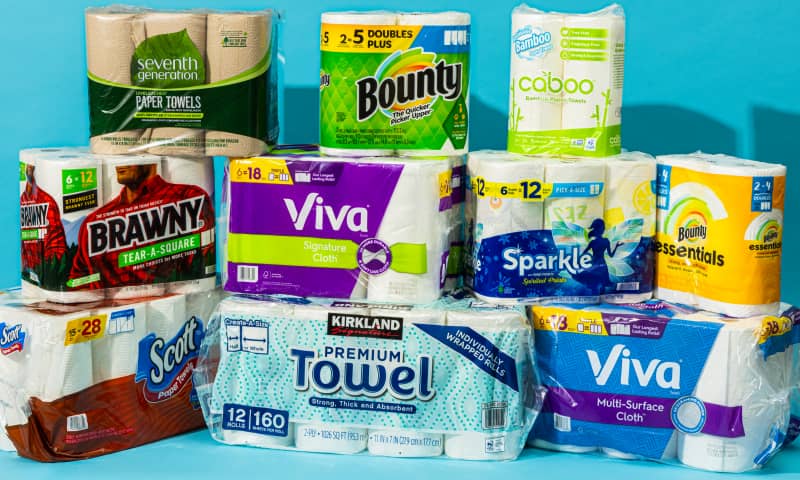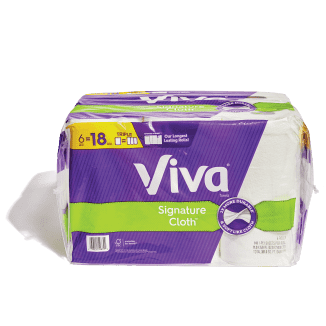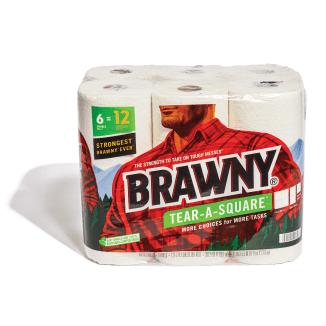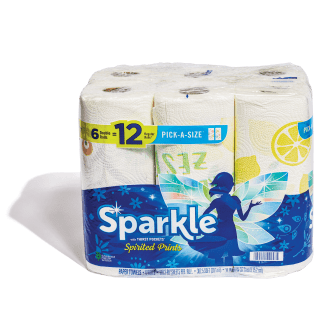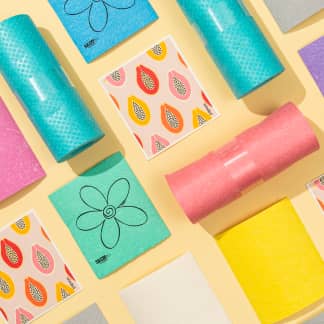Paper towels aren’t glamorous, but they’re essential in many households. After testing products from several brands, we chose two winners and a Best Buy. Bounty Select-A-Size Paper Towels, Triple Rolls, 6-pk were exceptionally strong and simultaneously soft to the touch. These thick sheets excelled at everyday cleaning tasks and even worked well for light scrubbing because of their raised diamond pattern. We also liked the Viva Signature Cloth Towels, Triple Rolls, 2-pk for their plush, cloth-like texture and strength; one sheet can endure multiple tasks. Our best buy towels are the Kirkland Signature Premium Paper Towels, 12-pk. They’re slightly thinner than our winners but still notably strong and absorbent—at two-thirds of the price.

We use paper towels for various kitchen needs, including wiping surfaces, drying produce, and sopping up spills. Although dish towels can also be used for these tasks, the convenience of a disposable product sometimes wins out, especially with messy jobs such as blotting raw meat, draining grease from food, seasoning skillets, and oiling grill grates.
We set out to learn everything we could about paper towels and find the best, most cost-effective options. With the help of Chicago-based market research firm Circana, we compiled a list of popular name brands, private-label favorites, bargain towels, and eco-friendly options to assess the market thoroughly. We ran our lineup through a range of tests that included analyzing their strength, cleaning various surfaces, drying our hands as well as loads of dishes, submerging the towels in tubs of water to evaluate absorbency, painstakingly tearing sheet after sheet off each roll to calculate value, and more.
What Are Paper Towels Made Of?
Most paper towels are two-ply and made from wood pulp, a fibrous material derived from softwood trees such as spruces or pines. Along with traditional wood pulp towels, there are a few bamboo paper options available. Many bamboo paper towel companies claim bamboo is more sustainable because it grows faster than softwood trees and requires less water to grow and process into a finished product. Bamboo or wood pulp can be virgin—harvested from fresh trees or plants—or recycled.
How Are Paper Towels Made?
The manufacturing process for paper towels, regardless of the raw material, is generally the same. It involves soaking wood chips or bamboo pieces in water and chemicals until they’re broken down into pulp. Chlorine is commonly added as a bleaching agent. Conditioners are added to improve strength and softness. Some manufacturers skip the bleaching process, leaving the pulp brown instead of turning it bright white. The pulp is then squeezed, rolled out, dried in large sheets, and later divided into smaller individual sheets. The sheets are then embossed, which involves stamping a design or pattern on the towels’ surfaces to brand them and increase absorbency.

Full Sheet versus Select-a-Sheet—What’s the Difference?
When shopping, you’ll see various paper towel products labeled as “full sheet” or “select-a-sheet.” Full-sheet products only allow you to tear off a sheet that typically measures around 11 inches long by 12 inches wide, while select-a-sheet products allow you to tear off either a full sheet or a half sheet of around 11 inches long by 6 inches wide. Many companies also advertise their products as double or triple, meaning there are more sheets per roll. However, the amount of sheets per roll differs drastically from one product to another; some of the rolls labeled as double or triple had 100 sheets while others had 180. Double and triple are mainly marketing terms to convey perceived value to shoppers. To understand the real correlation between number of sheets and value, we counted each sheet from every product and calculated the cost per sheet. We found that the actual number of sheets on each roll was more important than whether or not a product was labeled double or triple.
What to Look For
- Thick, Absorbent Sheets: Sheets ranged from a thickness of around 0.3 millimeters to 0.5 millimeters. We found that sheets that were in the 0.5-millimeter range could effortlessly soak up ¼ to ½ cup of water in a matter of seconds.
- Soft, Plush Sheets: Towels that had a soft texture felt better when we were drying our hands. They were also pleasant to use when shining or drying delicate glassware.
- More Sheets Per Roll: When shopping, disregard terms like “double” or “triple” and pay attention to the number of sheets per roll. Products with 124 or more select-a-sheet towels per roll provided the most value for the cost. When we did the math, most of the bigger brands were about one to two cents per sheet. You won’t need to buy paper towels as frequently when you have a moderate-to-large number of sheets on a roll with good absorbency and strength.

- Select-a-Sheet: Products that allowed us to choose how much paper towel we wanted to use helped us conserve rolls. We also liked the ability to customize the size of the towel for smaller tasks. When we weren’t overusing sheets we saved money in the long run.
What to Avoid
- Thin, Flimsy Sheets: Sheets that were less than 0.5 millimeters thick tore easily even during the simplest tasks such as wiping down countertops and cleaning windows, which meant we used more sheets. Cleaning products and the messes we were wiping up bled through them and onto our hands, which added to the cheap feel of these sheets. Thin sheets were also more prone to tearing unevenly when we ripped one from the roll.


Some towels were so flimsy and thin that they couldn’t withstand simple tasks like wiping up messy counters. On the other hand, sturdy, thicker sheets remained intact for multiple tasks—from wiping counters to cleaning windows.
- Rough-Textured Sheets: Towels that had a rough texture felt scratchy when we were drying our hands. They were also too scratchy for delicate glassware.
- Fewer Sheets Per Roll: Rolls with 110 or fewer sheets ran out too quickly. When we calculated the price per sheet, these rolls were the same price—or even more expensive in the case of the bamboo product—per sheet as the medium and large rolls. Small rolls were less cost-effective because we needed to purchase them more often.
Want to Save Money on Paper Towels? Buy the Expensive Brand.
Don’t make the mistake of taking prices at face value.- Full Size–Only Sheets: Products that had only full sheets meant it was harder to customize how much paper towel we used according to the task. Full sheets felt too big and even wasteful for tasks such as wiping up a small spill.
The Tests
- Measure sheet thickness and dimensions
- Count the number of sheets in each roll
- Rip sheets from paper towel holder to see if they tear evenly
- Place three sheets of each product in tub of water for 20 seconds and record amount of water absorbed
- Pass one sheet of each product across a semiabrasive cutting board 10 times
- Place container in center of each sheet and add incremental weight until it breaks to test strength
- Use towels to scrub spray cleaners off four different surfaces: wood, stainless steel, granite, and glass
- Dry wine glasses with each sheet
- Use each towel for everyday tasks for a week
- Have 10 testers use each brand of towel for a week
How We Rated:
- Absorbency: We recorded how much water each sheet absorbed and how quickly it wiped away cleaner/liquids from surfaces.
- Strength: We assessed how much weight each sheet could hold and how much scrubbing power it had before tearing or breaking.
- Ease of Use: We tested whether the sheets tore evenly from the rolls and how they felt when drying our hands.
- Cleaning: We observed how well the towels cleaned various surfaces and if they left behind streaks or lint.
